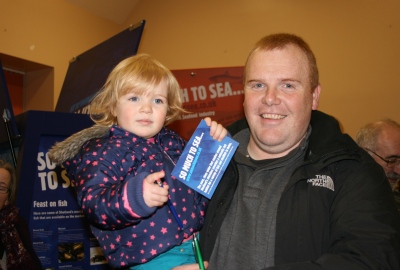‘SO MUCH TO SEA’ HITS THE ROAD
Seafood Shetland officially launched its ‘So Much to Sea’ project last week, which aims to put the local seafood industry in the spotlight and build awareness of its social and economic impact upon the islands.
Representatives from the industry and public sector together with contributors to the project gathered at the NAFC Marine Centre in Scalloway on Wednesday 12 February to preview an exhibition and film, which highlights just what the seafood industry means to Shetland’s communities and how it influences Shetland as a whole.
Councillor Allan Wishart, who attended the launch, commented: “The film was absolutely brilliant and everyone involved must be congratulated on producing such a factual, uplifting, revealing, moving and emotive piece of marketing work.”
‘So Much to Sea’ then kicked off the first of its six community events at the Bigton Hall on Saturday night. Some 200 folk gathered to lend their support and discover more about the industry – which is worth £300 million a year to the local economy.
People had a chance to mingle and enjoy supper, hosted by the Bigton Hall committee, take in the film and exhibition, whilst enjoying music with a sea-related theme from Eunice Henderson and the South Mainland Young Fiddlers, as well as trying some tempting seafood samples.
James Martin from the Peerie Shop Café cooked up some mouth-watering seafood treats throughout the evening, encouraging folk to try something new whilst highlighting how fresh and easy the seafood produce that is available locally is to work with. Dishes included monkish wrapped in parma ham; mussels in white wine; and a bouillabaisse with squid, gurnard, cod and monkfish. With food provenance at the fore of many people’s minds, the audience were able to find out where the seafood they were eating was from. In this instance, the fish was from the Cullivoe-based whitefish boat Guardian Angell LK 272 (caught around 20 miles north of Ronas Voe) and prepared at QA Fish in Scalloway. The mussels were grown and farmed in Walls and supplied by Shetland Mussels Ltd.
Chief Executive of Seafood Shetland, Ruth Henderson, was delighted with the turnout. She said: “It was a fantastic evening and great to see so many folk come along. We’ve had some really positive feedback on the whole initiative. The film, in particular, has attracted much interest, by the way in which it gives a candid, human insight into the industry. It has already had over 3,000 viewings online.
“It has been really heartening to hear people say that they have learnt more about the significance of Shetland’s seafood. I would encourage people to come along to one of the hall events and visit the website www.somuchtosea.co.uk where they can find out more. We are also keen that people send in any relevant stories or photographs, so that we can start to build up a useful Shetland-based community resource on the industry. This project is very much about leaving a legacy and I hope that the general public will help us achieve that.”
Commenting on the film, John Goodlad, Chairman of the Board of Shetland Catch and Chairman of the Scottish Pelagic Sustainability Group, said: “It is excellent. Well made, well filmed and portrays the industry in the right kind of way – young people working in a high tech, modern and sustainable sector. The film and the series of showings around Shetland is exactly the right kind of message to convey.”
Burra Hall, 22 February, 4 – 7pm;
Walls Hall, 1 March, 5 – 7pm;
Vidlin Hall, 8 March 4 – 7pm;
Cullivoe Hall, 21 March, 5 – 8pm and
Symbister Hall, 29 March, 12.00 – 3.30pm.
Key background facts to the Shetland seafood industry:
• Shetland’s seafood industry is worth £300 million a year, including aquaculture, and processing industries.
• The industry surpasses oil, gas, agriculture, tourism, and creative industries combined.
• Around 1,000 people are directly employed in the sector. Hundreds more jobs depend on fishing, in, for example, fish processing, marketing, transport supply and engineering.

